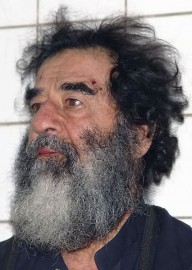

The trail to Hussein would be carefully developed by intelligence professionals using solid Human Intelligence or HUMINT tradecraft and detailed analysis techniques.įollowing the collapse of Hussein's regime, the 4th Infantry Division occupied the area in and around Tikrit, Hussein's family home. A nine-month hunt for the deposed president followed. Within three weeks, US forces secured Baghdad, but Hussein had escaped the capital city.
#Saddam hussein capture photo free
On March 20th, 2003 Coalition troops invaded Iraq to oust dictator Saddam Hussein from power and free the Iraqi people. The script of that video is excerpted here. In an effort to highlight the intelligence aspects of this milestone event, the Intelligence Center of Excellence History Office has developed a five-minute video case study entitled: "The Capture of Saddam Hussein: Human Intelligence Out Front." The video can be accessed from the History Office located inside the MI Library on Fort Huachuca. The story of how he was located and captured is an intelligence success story. Within weeks it was all over the Internet, and Samir says initially the Pentagon was irate.Įight years on, this image is one of the most iconic to emerge from the war.Ten years ago this week, the US Army captured Iraqi dictator Saddam Hussein alive. No one had ever treated him this way.”Īfter the capture came a night of partying, and after that, an exhilarated Samir uploaded the image to his laptop. He wasn’t crying, but I think he was shocked. I stepped my foot on his head and his back. “I told him he was a criminal and a murderer. “I told him that I was going to f- him up the a–,” Samir told the St. Minutes later, Samir was dragging Saddam out of his spider hole, the deposed dictator begging the soldiers not to shoot. That very night, a US Army brigade was deployed, with Special Forces interrogating the men in the farmhouse and Samir in the field with the bodyguard, who kept insisting that Samir was standing right on top of Saddam Hussein. Upon arrival, the bodyguard also divulged that Saddam was hiding underground. The military was skeptical, but Samir and few other intel agents put the bodyguard in a van and took him to the site. After two hours and threats of a beating, the bodyguard cracked. The interrogation was led by Samir, who conducted his questioning from a semi-throne. 13, when US Special Forces captured one of Saddam’s former bodyguards and brought him to intelligence officials housed in a palace in Tikrit.

Samir became a key player on the afternoon of Dec. “We knew we had a pretty good feel for it,” says Russell. It wasn’t until June 2003 that the US military had credible enough information regarding Saddam’s whereabouts. His expertise was invaluable throughout the nine-month hunt for Saddam, who, it seemed, might never be found. In the wind-up to the US-led invasion in March of that year, Samir took a translator test and quickly returned to Iraq, working for a civilian contractor. Samir found work in an auto-parts shop and lived a quiet Midwestern American life until early 2003, when it became clear the United States was about to invade Iraq. He spoke very little English and had less than $10 to his name, but he was fascinated by America, most of his knowledge coming from Clint Eastwood movies. He spent over three years languishing in a refugee camp in Saudi Arabia until finally, in early 1994, Samir was relocated to St.
#Saddam hussein capture photo full
He was part of the uprising in 1991, but when US forces withdrew, Saddam unleashed the full force of his military power against the Shiite rebels - Samir’s uncles and cousins among them. Samir is an Iraqi native who was granted political asylum after the first Gulf War. Steve Russell has included the unaltered photo, in which Saddam’s captor, known only as Samir, looks right at the camera, his expression a palpable mixture of anger and joy. In the new book “We Got Him! A Memoir of the Hunt and Capture of Saddam Hussein” (Threshold Editions), author and former Lt. He was an Iraqi native-turned-American-translator, and not that long ago, Saddam had killed his relatives and thrown his father in jail. Turns out that serviceman wasn’t a soldier, or even American.

In the years since, it’s floated around the Web, but unless you’ve gone looking for it, you’ve probably seen the most circulated version, in which the face of the US serviceman holding a freshly excavated Saddam Hussein is blurred.

It’s one of the defining images of the Iraq War, the capture of Saddam Hussein by US forces on Dec.


 0 kommentar(er)
0 kommentar(er)
